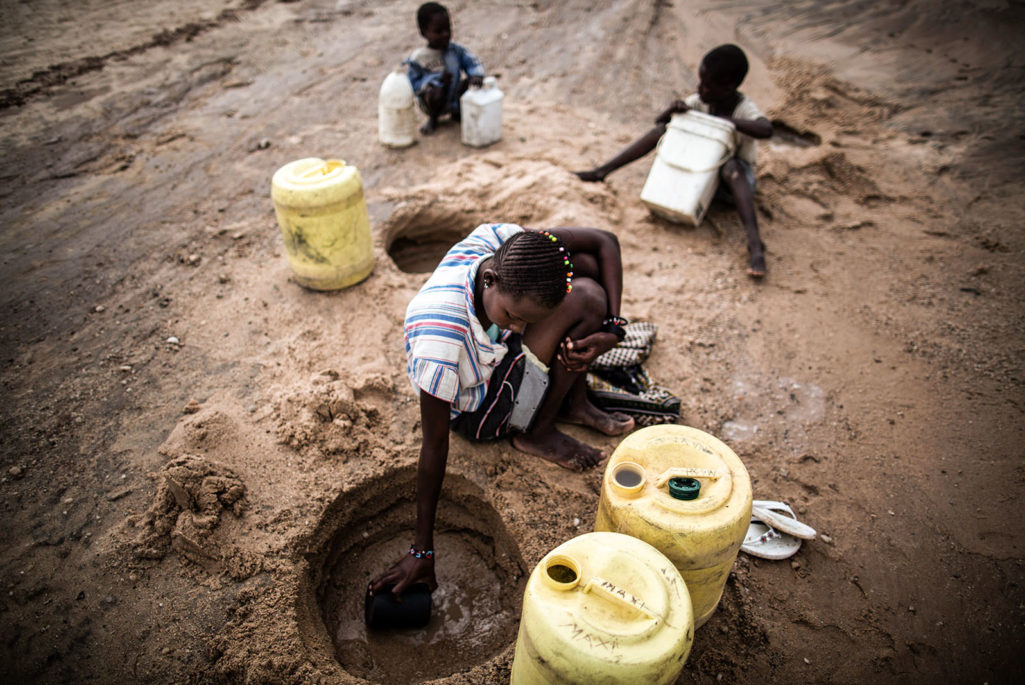Shaping Conflict in the 21st Century—The Future of Food and Water Security

A Turkana woman scoops water from a dry river bed in Nasder, Kenya. A first downpour relieved pastoralists in the drought stricken Kenyan Turakana region after a twelve month span that pushed livestocks and communities to the brink of another looming humanitarian crisis.
Photo: Marco Longari/AFP/Getty Images
Food and water security will shape the 21st century. The interconnection between the availability and access to natural resources, political and economic stability, community wellbeing and the potential for conflict are indisputable. Those who view security through a traditional lens risk overlooking the complexities of conflict triggers as we move further into the 21st century.
Over the next 35 years, population growth, reduced access to fresh water and declining arable land will place mounting pressure on global food and water security. The greatest pressure will be on those countries least equipped to deal with these challenges, increasing the risk of both inter- and intra-state conflict.
Food and water insecurity is not necessarily about a dearth of resources—we have enough food and water globally to meet demand. But demand for food and water is expected to outpace the supply of globally available resources. The majority of the world’s population growth to 2050 is expected to occur in Asia and Sub-Saharan Africa, but both regions are ill-equipped at present to access the required resources and meet the basic needs of their growing populations.
Population Growth and Movement
By 2050, an increasing number of countries will be unable to feed their people or quench their thirst for water. Land and water won’t move, but food and people can—and will—in response to resource scarcity. Consequently, food systems and markets around the world will continue to become progressively interdependent. In the case of food shortages, we can expect increased migration, across states and regions—but this is likely to intensify the potential for conflict.
The challenge of dealing with refugees largely falls on ill-equipped countries struggling with their own land, food, and water insecurity. For example, Yemen already houses a large number of internally displaced persons due to civil conflict, as well as a large number of refugees from the food-insecure and war-torn Horn of Africa. And now it is expected to become the world’s first source of water-refugees. Yemen’s capital, Sana’a, will likely become the first major city in the world to run out of water in the coming decades.
Land and water won’t move, but food and people can—and will—in response to resource scarcity.
Water Security
Increased resource scarcity will encourage states with arable land or freshwater shortages to become more aggressive in their efforts to expand their resource base. This will most likely manifest in states encroaching on shared resources such as transboundary river basins. There are 263 international basins that cross the political boundaries of two or more countries. These basins cover approximately half of the earth’s surface area and account for an estimated 60 percent of the global freshwater flow.
The Himalayan region is fast emerging as the most likely region for transboundary water disputes and competition in the world. Located about 4,500 meters above sea level, the Tibetan Plateau in the Himalayan Region is the largest repository of fresh water in the world after the Arctic and Antarctic regions. The source for a number of the world’s greatest river systems, this watershed supports close to half the world’s population across China, South Asia and Southeast Asia.
China, driven by severe water shortages and polluted water systems, has begun to harness the plateau’s water resources and divert it to the state’s industrial and densely populated northeast. This has led to heightened tensions with downstream riparian states that rely on the Tibetan Plateau as a means of livelihood, food and water security. Any diversion or damming upstream has the potential to negatively affect downstream riparian states. As water scarcity and degradation rises in many of these states, tensions over water allocations and control will grow. Efforts to find mutually beneficial solutions to water sharing issues will be necessary to reduce the risk of conflict and improve regional water security.
Food Security
Most food motivated conflict between now and 2050 is likely to take the form of civil unrest, largely because more than 80 percent of food produced is consumed within its country of origin.
Egypt, for example, has a strong historical link between civil unrest and food security. Bread riots are not uncommon. Rising prices and poor access to food triggered riots in 2008 and were a key contributing cause for the revolution in 2011. Currently, the state is stuck in a downward spiral; desperately requiring the phasing out of food and fuel subsidies to ensure economic stability and growth, the very act of doing so could lead to increased protests and insecurity. Food security and pricing will continue to play a critical role in Egyptian politics.
In his book, The Coming Famine, Julian Cribb writes that the wars of the 21st century will involve failed states, rebellions, civil conflict, insurgencies and terrorism. All of these elements will be triggered by competition over dwindling resources, rather than global conflicts with clearly defined sides.
More than 40 countries experienced civil unrest following the food price crisis in 2008. The rapid increase in grain prices and prevailing food insecurity in many states is linked to the outbreak of protests, food riots and the breakdown of governance. Widespread food insecurity is a driving factor in creating a disaffected population ripe for rebellion. Given the interconnectivity of food security and political stability, it is likely food will continue to act as a political stressor on regimes in the Middle East and elsewhere.
Addressing Insecurity
Improving food and water security and encouraging resource sharing is critical to creating a stable and secure global environment. While food and water shortages contribute to a rising cycle of violence, improving food and water security outcomes can trigger the opposite and reduce the potential for conflict.
With the global population expected to reach 9 billion by 2040, the likelihood of conflict exacerbated by scarcity over the next century is growing. Conflict is likely to be driven by a number of factors and difficult to address through diplomacy or military force. Population pressures, changing weather, urbanization, migration, a loss of arable land and freshwater resources are just some of the multi-layered stressors present in many states. Future inter-state conflict will move further away from the traditional, clear lines of military conflict and more towards economic control and influence.
Any efforts to limit or mitigate inter- and intra-state conflict must necessarily include proactive, collaborative and global solutions. Taking action on climate change, adopting greater long-term sustainability practices across all industries, and responding to scarcity as and where it occurs, are only a handful of the preventative measures required. National interests may need to be supplanted by the necessity to prioritize what is best for an increasingly globalized system. Food and water insecurity in any part of the world affects everyone. What is ultimately required is unprecedented international cooperation.




